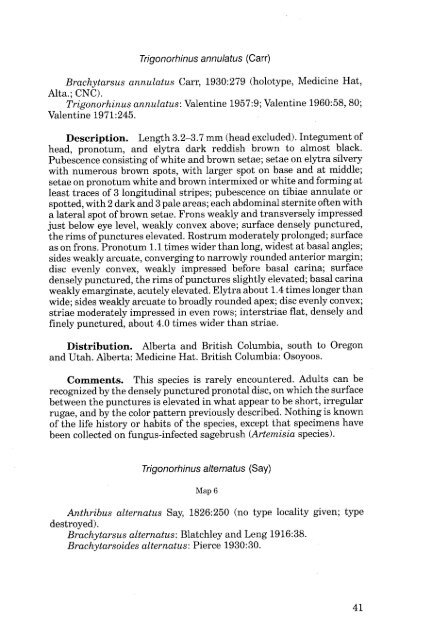Weevils - Entomological Society of Canada
Weevils - Entomological Society of Canada
Weevils - Entomological Society of Canada
Create successful ePaper yourself
Turn your PDF publications into a flip-book with our unique Google optimized e-Paper software.
Trigonorh i n u s an n u I atu s (Carr)<br />
Brachytarsus annulatus Carr, 1930:279 (holotype, Medicine Hat,<br />
Alta.;CNC).<br />
T rigonorhinu s annulatus : Valentine 7957 :9 ; Valentine 1960 : 58, 80 ;<br />
Valentine 1971:245.<br />
Description. Length 3.2-3.7 mm (head excluded). Integument <strong>of</strong><br />
head, pronotum, and elytra dark reddish brown to almost black.<br />
Pubescence consisting <strong>of</strong> white and brown setae; setae on elytra silvery<br />
with numerous brown spots, with larger spot on base and at middle;<br />
setae on pronotum white and brown intermixed or white and forming at<br />
least traces <strong>of</strong> 3 longitudinal stripes; pubescence on tibiae annulate or<br />
spotted, with 2 dark and 3 pale areas; each abdominal sternite <strong>of</strong>ten with<br />
a lateral spot <strong>of</strong> brown setae. Frons weakly and transversely impressed<br />
just below eye level, weakly convex above; surface densely punctured,<br />
the rims <strong>of</strong> punctures elevated. Rostrum moderately prolonged; surface<br />
as on frons. Pronotum 1.1 times wider than long, widest at basal angles;<br />
sides weakly arcuate, converging to narrowly rounded anterior margin;<br />
disc evenly convex, weakly impressed before basal carina; surface<br />
densely punctured, the rims <strong>of</strong> punctures slightly elevated; basal carina<br />
weakly emarginate, acutely elevated. Elytra about 1'4 times longer than<br />
wide; sides weakly arcuate to broadly rounded apex; disc evenly convex;<br />
striae moderately impressed in even rows; interstriae flat, densely and<br />
finely punctured, about 4.0 times wider than striae.<br />
Distribution. Alberta and British Columbia, south to Oregon<br />
and Utah. Alberta: Medicine Hat. British Columbia: Osoyoos.<br />
Comments. This species is rarely encountered. Adults can be<br />
recognized by the densely punctured pronotal disc, on which the surface<br />
between the punctures is elevated in what appear to be short, irregular<br />
rugae, and by the color pattern previously described. Nothing is known<br />
<strong>of</strong> the life history or habits <strong>of</strong> the species, except that specimens have<br />
been collected on fungus-infected sagebrush (Artemisia species).<br />
Tr i go n o rh i n us a/ternatus (SaY)<br />
Map 6<br />
Anthribus alternatus Say, 1826:250 (no type locality given; type<br />
destroyed).<br />
Brachytarsus q.lternatus: Blatchley and Leng 1916:38.<br />
Brachytarsoides alternalus: Pierce 1930:30.<br />
47

















